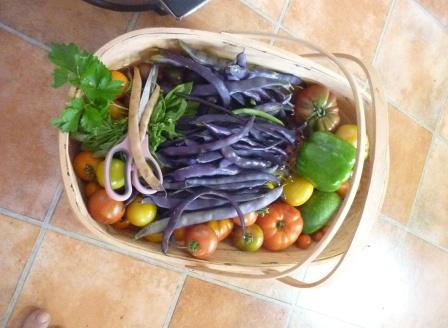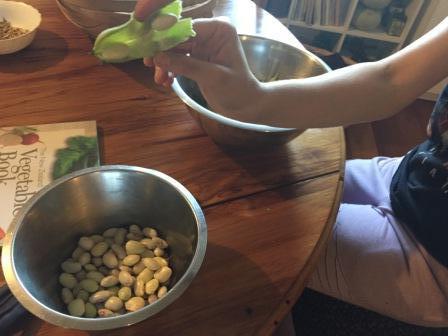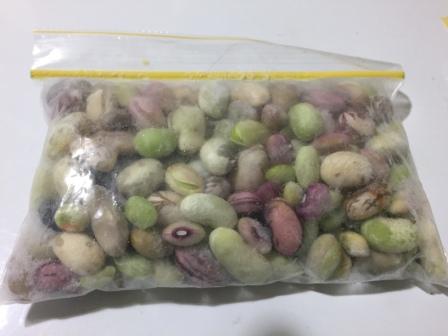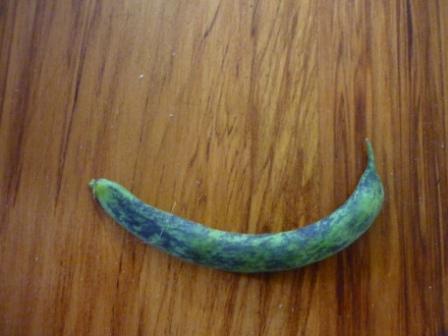 |
|
| > Welcome > Grow and Eat > What Exactly are Shelling or Podded Beans?
|
|
What Exactly are Shelling or Podded Beans?There I was in the midst of the climbing beans, contentedly tucking and twining vines in and out of the wire netting, when my Mum pointed at a fat bulging bean on the vine, “I just hate it when my beans get so old and tough they can’t be eaten, like those ones.” I know just what my Mum meant. Until recently, I was only interested in harvesting beans that were young, fresh, snappy and juicy. We know them as green beans, snap beans or string beans. That was before friend and growing guru Mark Christensen of Heritage Food Crops Research Trust gifted me bean seeds when we moved back to New Zealand. Wow, those beans with amazing names like Fat Goose, Good Mother Stallard, Cherokee Cornfield and Lazy Wife grew and grew and grew! I felt like I was living in the land of Jack and the Beanstalk! We ate snap beans every day from December until February, we froze dozens of bags of snap beans for winter, and jumped for joy when family came to stay becuse we could serve huge platters of snap beans every day! By the way, steamed snap beans are DELICIOUS topped with toasted chopped almonds and a little olive oil or coconut oil and salt! Then I thought, “Mark gifted me these bean seeds, the least I can do is grow some of the beans on and try them as freshly shelled beans, and perhaps dry some for winter.” Shelling Beans are Grown up Snap Beans!You see, the snap beans, the ones that are snappy and juicy are really just immature pods. You can see the tiny seed inside a cut snap bean. When you let the bean stay on the vine, the tiny seed inside begins to swell and grow, until the bumps are showing through the pod, and feel very firm and full when you press them. Fresh snap beans are about 85% water, and have good levels of those magical polyphenols which ward off disease as they keep free radicals in check. Fresh shelled or podded beans have higher levels of protein, iron and vitamins, more calories along with starches and fibres for the digestive system, compared with green or snap beans. Actually these fibres and starches are not technically digestible, but are wonderful food for the microorganisms in our digestive systems. Just the same as their dried up relatives - the dry beans we see in stores! A Bean Secret I'm Sharing TodayThere is just one problem, something I haven’t shared with you yet. It’s a little bit embarrassing for someone who loves plant food. You see, for many years now I have not been able to eat and digest any kind of legume.
I know, very tragic. The Bean Experiment BeginsStill I’m always one for experiments! We waited until the bean pods on the vines became swollen, the skins becoming harder and more fibrous by the day, the lumps and bumps of the beans looking as if they were going to burst! One variety turned a shocking pink colour, an easy way to know the beans are ready to be shelled! And then the day came and we decided to start harvesting the beans for shelling, also known as podding the beans. The pile of pods grew and grew, while the pile of shelled beans looked far more modest. Next, we measured a cup or so of the shelled beans into small freezer bags, lay the bags flat on a tray and popped them into the freezer. Then the test came. Would I be able to eat AND digest the freshly shelled beans, without cramps, nausea, constipation, bad breath and skin issues for days afterwards? We carefully selected a recipe from one of our favourite books: Feasts of Provence by Robert Carrier, and set about making La Soupe au Pistou. Of course we had to make some changes to the Pistou sauce to be plant based. The flavours were marvellous, the texture was satisfying, and then the first bean... Delicious. I felt a little tear in my eye. How many years since I’d eaten a cooked bean? And the next day....no side effects! And the day after that...no side effects! Even a week out there was no cracking skin, no rashes, no nausea, no bloating or cramping. At last, I’d found a way to be able to eat legumes and remain healthy and well. Perhaps the starches in the freshly shelled beans are more digestible for me, perhaps growing in our local environment instead of eating beans grown in a faraway place made them more digestible for me. The answer is not yet clear. Yet I have been able to eat freshly shelled beans two years in a row, and two different locations. I encourage you to be brave enough to let some of your summer beans grow on, and give freshly shelled or podded beans a chance! If you live in New Zealand, you can email Mark Christensen and ask for a sample of beans to grow in your garden. Wherever you live, there is a variety of bean to suit your climate. God bless you as you search for and discover the foods that are healthy for you! References: https://www.heritagefoodcrops.org.nz/heirloom-beans http://beaninstitute.com/bean-nutrition-overview/ https://www.nutrition.org.uk/healthyliving/basics/fibre.html https://www.glnc.org.au/legumes/legumes-nutrition/
Posted: Mon 20 May 2019 |
|
|




